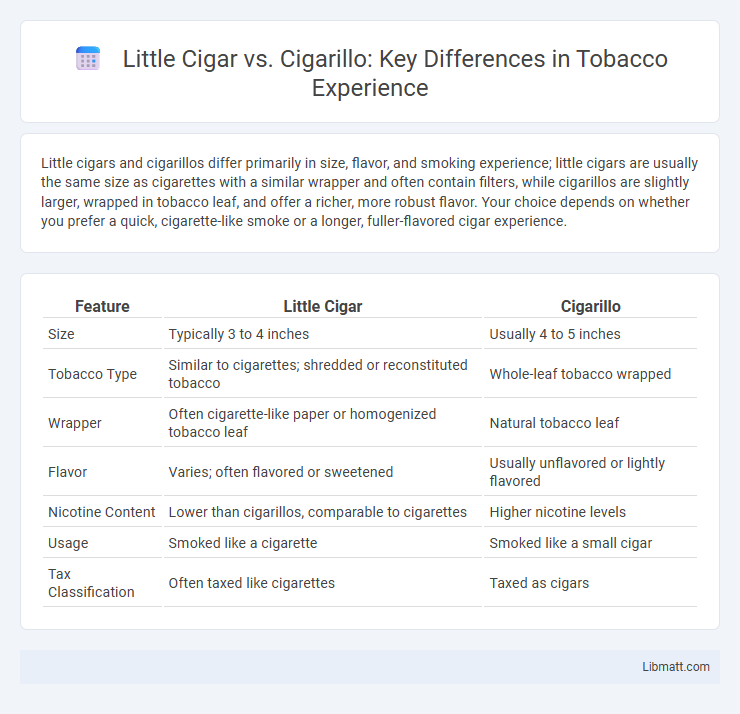Little cigars and cigarillos differ primarily in size, flavor, and smoking experience; little cigars are usually the same size as cigarettes with a similar wrapper and often contain filters, while cigarillos are slightly larger, wrapped in tobacco leaf, and offer a richer, more robust flavor. Your choice depends on whether you prefer a quick, cigarette-like smoke or a longer, fuller-flavored cigar experience.
Table of Comparison
| Feature | Little Cigar | Cigarillo |
|---|---|---|
| Size | Typically 3 to 4 inches | Usually 4 to 5 inches |
| Tobacco Type | Similar to cigarettes; shredded or reconstituted tobacco | Whole-leaf tobacco wrapped |
| Wrapper | Often cigarette-like paper or homogenized tobacco leaf | Natural tobacco leaf |
| Flavor | Varies; often flavored or sweetened | Usually unflavored or lightly flavored |
| Nicotine Content | Lower than cigarillos, comparable to cigarettes | Higher nicotine levels |
| Usage | Smoked like a cigarette | Smoked like a small cigar |
| Tax Classification | Often taxed like cigarettes | Taxed as cigars |
Introduction to Little Cigars and Cigarillos
Little cigars and cigarillos are both tobacco products that resemble cigarettes but differ in size, flavor, and usage. Little cigars are typically about the size of a cigarette, wrapped in tobacco leaf or brown paper containing tobacco, often filtered and flavored. Cigarillos are longer, thicker, and generally unfiltered, offering a richer tobacco flavor and are often smoked slowly like traditional cigars.
Definition: Little Cigar vs. Cigarillo
Little cigars closely resemble traditional cigarettes in size and shape, often wrapped in tobacco leaf or brown paper, and usually contain filtered tobacco. Cigarillos are slightly larger, unfiltered, and wrapped in natural tobacco leaf, offering a richer flavor and longer smoking experience. Understanding the distinction helps you choose the right smoking product based on preference and tobacco content.
Differences in Size and Shape
Little cigars are typically smaller and resemble cigarettes in shape, measuring about 7 to 10 centimeters in length with a tighter, more uniform cylinder design. Cigarillos are longer, often ranging from 10 to 15 centimeters, and have a thicker, more tapered shape that mimics traditional cigars. Understanding these differences in size and shape can help you choose the right smoking experience based on your preferences and occasion.
Tobacco Content Comparison
Little cigars typically contain more tobacco than cigarillos, averaging around 3 to 5 grams compared to cigarillos' 1 to 3 grams. The higher tobacco content in little cigars results in a longer smoking duration and a stronger nicotine delivery. Your choice between the two may depend on your preference for tobacco intensity and smoking experience.
Flavor Profiles and Additives
Little cigars typically have flavor profiles similar to traditional cigars but often include additives such as sweeteners and flavor enhancers to appeal to a broader smoking audience. Cigarillos, on the other hand, usually offer bolder, more intense tobacco flavors with fewer additives, emphasizing the natural tobacco taste. Both products may contain artificial flavorings, but little cigars are more commonly infused with flavors like vanilla, cherry, or honey to mask harsher tobacco notes.
Smoking Experience: Strength and Smoothness
Little cigars typically offer a stronger and more robust smoking experience due to their denser tobacco content, providing a rich, full-bodied flavor. Cigarillos, on the other hand, are usually milder and smoother, often preferred by those seeking a lighter and more refined taste. Your choice between the two depends on whether you prioritize intensity or smoothness in your smoking experience.
Packaging and Presentation
Little cigars often come individually wrapped or in small packs resembling cigarette packaging, emphasizing convenience and portability for on-the-go use. Cigarillos are typically sold in foil or plastic packaging, sometimes in multi-packs, highlighting freshness and extended shelf life. Your choice between little cigars and cigarillos may depend on your preference for compact, discreet packaging versus larger, resealable presentations.
Price and Accessibility
Little cigars typically cost less than cigarillos, making them a more budget-friendly option for smokers. They are widely available in convenience stores, gas stations, and online, ensuring easy accessibility for most consumers. Cigarillos, while slightly pricier, are often sold in specialty tobacco shops and may be less accessible in some regions.
Health Risks: Little Cigar vs. Cigarillo
Little cigars and cigarillos both carry significant health risks due to their tobacco content and harmful chemicals, including increased risks of lung cancer, heart disease, and respiratory issues. Little cigars are often similar in size and composition to cigarettes, which may lead to higher inhalation rates and greater exposure to toxins compared to cigarillos, which are typically larger and smoked differently. Understanding these distinctions helps you make informed choices about tobacco use and its impacts on your health.
Which is Better: Choosing Between Little Cigar and Cigarillo
Little cigars offer a similar smoking experience to cigarettes, making them a preferred choice for smokers seeking convenience and affordability. Cigarillos, typically larger and available in varied flavors, provide a richer and longer-lasting smoke ideal for those valuing flavor complexity and duration. The decision between little cigars and cigarillos depends on individual preferences for size, flavor intensity, and smoking time.
little cigar vs cigarillo Infographic

 libmatt.com
libmatt.com